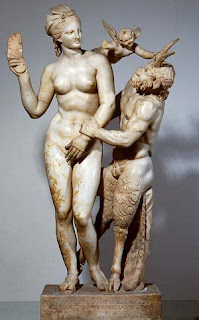Sunday, February 27, 2011
February 27
The Equirria (Festival of Mars - held on February 27, First Equirria and March 14, Second Equirria) were holy days with religious and military significance at either end of the new year celebrations for Mars. The Roman state placed great emphasis on celebrating the god of war - to support the army, and to boost public morale. Priests performed rites purifying of the army. Celebrants held horse races on the Campius Martius (field of Mars), and drove a scapegoat out of the city of Rome, expelling the old and bringing in the new.
Thursday, February 24, 2011
February 24
- Nunc mihi dicenda est regis fuga. Traxit ab illa sextus ab extremo nomina mense dies. Ultima Tarquinius Romanæ gentis habebat regna, vir iniustus, fortis ad arma tamen.
-
- (Now I must tell of the flight of the King, six days1 from the end of the month. The last of the Tarquins possessed the Roman nation, an unjust man, but nevertheless strong in war.)
Wednesday, February 23, 2011
Tuesday, February 22, 2011
February 22
Monday, February 21, 2011
Thursday, February 17, 2011
February 17
Wednesday, February 16, 2011
February 16
Tuesday, February 15, 2011
February 15
Upcoming lecture! 2/22/11 - HERODOTUS, ARISTOTLE, AND SOUNDING WEIGHTS: THE DEEP SEA AS A FRONTIER IN THE CLASSICAL WORLD
Dr. John Peter Oleson, Department of Greek and Roman Studies, University of Victoria
HERODOTUS, ARISTOTLE, AND SOUNDING WEIGHTS: THE DEEP SEA AS A FRONTIER IN THE CLASSICAL WORLD
The ancient Mediterranean cultures knew far more about the deep sea than is generally realized. Pharaohs, emperors, scientists, fishermen, ships’ captains and sponge divers were all personally concerned with the topography and environment of the sea floor. Comments by the scientist-philosophers Aristotle and Posidonius indicate that by the early Hellenistic period, many areas of the Mediterranean Sea had been accurately measured down to 2000 m. This was an impressive accomplishment given the materials and technology available at the time. Both the difficulty of the undertaking and the apparently comprehensive scope of the inquiry reveal a profound and, so far, underrated interest in the deep sea among Greek and Roman intellectuals. In a richly illustrated talk, Prof. Oleson presents the surprising results of his research concerning ocean science and navigation in the ancient Mediterranean.
Suggested Bibliography/Websites
· J.P. Oleson, “Ancient Sounding-weights: a contribution to the history of Mediterranean navigation,” Journal of Roman Archaeology 13 (2000) 293-310.
· J.P.Oleson, “Testing the Waters: The Role of Sounding-Weights in Ancient Mediterranean Navigation,” pp. 119-76 in R.L. Hohlfelder, ed., The Maritime World of Ancient Rome. Memoirs of the American Academy in Rome, Suppl. 6. Ann Arbor: University of Michigan Press, 2008.
Lupercalia: How Whipping Equates Fertility – (1st C BC)
 Every year on February 15th, the ancient Romans celebrated the Lupercalia festival in honor of the she-wolf who suckled their founders – twin brothers Romulus and Remus – when they were infants. The festival was meant to purify the city and ensure fertility… however, the rituals involved were perhaps some of the strangest traditions ever practiced in ancient Rome. Oddly enough, by the time the festival was at the height of its popularity in the 1st century BC, the Romans had forgotten most of the festival’s origins, even to which gods it was originally dedicated.
Every year on February 15th, the ancient Romans celebrated the Lupercalia festival in honor of the she-wolf who suckled their founders – twin brothers Romulus and Remus – when they were infants. The festival was meant to purify the city and ensure fertility… however, the rituals involved were perhaps some of the strangest traditions ever practiced in ancient Rome. Oddly enough, by the time the festival was at the height of its popularity in the 1st century BC, the Romans had forgotten most of the festival’s origins, even to which gods it was originally dedicated.

Monday, February 14, 2011
February 14
Sunday, February 13, 2011
Saturday, February 12, 2011
February 12
| February 12A day holy to Diana. |
One of the stories says that Artemis (or the Roman goddess Diana) took Hippolytus, son of Theseus, after he was brought to life again by Asclepios, and brought it to Italy, at her temple in Aricia, where he became her priest, under the name Virbius (he who lived twice).
And a curious fact: in the Romanian language, the Latin name of the Roman goddess Diana became the word “zana”, which means “fairy”. In folk tales, the fairies would usually wander through the woods, in large groups. In many tales, a young man sees the fairies bathing and steals some clothes. When they discover someone is watching, they get out of the water, get dressed and fly away. The fairy whose clothes were stolen can’t go away, so she hides behind a bush, promising to marry him if he gives her back her clothes (which have magical powers). The young man refuses and gives her other clothes, they marry and they live happily for a while, until, one day, she manages to find her fairy clothes. When she does, she can fly back to her sisters, leaving her son and her husband, who will be forever sad. Because, when someone was married to a fairy, the other women mean nothing to him any more. Not exactly Actaeon's story, but anyway, the man who saw the fairies naked is punished for this, with an eternal sadness.
Wednesday, February 9, 2011
February 9th

February 9th is Showtime for Apollo, the sun god of the ancient Greeks, whose chariot rode across the heavens each day. February 9 wasn’t the only feast for Apollo. The Spartans celebrated Apollo in August (Carneia). The Athenians celebrated his birthday in May (Thargelia) and held a harvest festival in his honor in October (Pyanepsia). But according to Roman records, at some point the Festival of Apollo was celebrated on the Vth (5th) day before the Ides (13th) of February. Unlike the Ides of March, the Ides of shorter months were observed on what we consider the 13th of the month, not the 15h. Yes, the 9th is actually four days before the 13th, not five, but the Romans always included the dates they were counting from and to. In other words, by Roman calculations Wednesday would be three days before Friday, and the 9th would five days before the 13th. (Don’t think about it, just thank the Arabs.) + + + In the Christian Era, February 9 became the Feast Day of St. Apollonia and the Martyrs of Alexandria. No they weren’t ancient Egypt’s pop fusion sensation, but a group of early Christians who were killed in 249 AD by angry pagan mobs. Among the Christians was Apollonia, whose teeth were beaten out. Then, when she was ordered to renounce Christ or be burned alive, she leapt into the fire to meet her death. + + + In more recent times, a third Apollo milestone occurred on February 9: Sixty-eight years after the Wright Brothers’ historic flight at Kitty Hawk, another charioteer of the heavens, Apollo 14, splashed into the Pacific Ocean on February 9, 1971, having completed a successful mission on the moon. Though not the first trip to the moon, Apollo 14 was a much needed success after the disastrous Apollo 13 mission, in which man’s cutting-edge technology crashed down to Earth in Icarian defeat. More important, Apollo 14 was the first time in history that anyone played golf on a planet other than Earth. (Okay, technically, a satellite, but still…) Alan Shepard attached a six-iron head to a metal collection device, with which he hit two golf balls on the surface of the moon. Shepard was admittedly no Tiger Woods… Actual transcript:
No, I’m not making that up. Fortunately, Shepard’s third swing went “miles and miles and miles” by his own calculation. Shepard’s estimate was later reduced to only a few hundred yards. Either way, the drive was indisputably out of this world…  |
Tuesday, February 8, 2011
Teleconference Lecture Tomorrow : "The Battle of Marathon and Modern Sports"
Speaker: DEAN KARNAZES
1:00 PM ET/ 10:00 AM PT (90 minute lecture and Q&A)
Free registration: http://marathon2500-5.eventbrite.com














